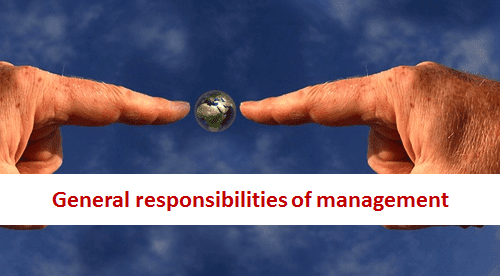
List of responsibilities of managers
They are what holds it together and makes it work.” (Drucker, 1987). This generic definition can be translated into the following, more specific, list of responsibilities of managers:
- they should ensure that the organization produces specific goods or services;
- they must design and maintain stability of the operations that take care of production;
- they should continually adapt the organization to its changing environment (Mintzberg, 1973);
- they should distribute information between the environment and the organization.
They take care of the products (or services)
Since one of the primary concerns of senior managers is to take care of products, I believe that such a significant responsibility should be reflected in the design of the interface of a business intelligence system. Customers who buy the products give the organization her right to exist. If an organization has no customers, no organization is needed since processing input into valuable output is redundant and superfluous. Therefore, managers should not overlook product- and customer related measures.
Customer and product related components first
Thus, I suggest that if it is necessary for hundreds of measures and dimensions to be accessible, customer and product related dimensions and measures should have a more prominent place on the screen. However, the customer is the reason for this exercise. The customer is the cause of the organization; he is the first link of the chain of organizational processes and the interface can be organized to mirror this. The customer related measures may be presented first (for example, is there enough work available for a selected time period and are the resources available to accomplish this) and from that point, the manager is able to traverse a tree of secondarily important views (for example, the risks that may influence these two former types of indicators).
Make the organization agile
The third responsibility, to adapt the organization to its changing environment, is very broad and unspecific. However, one thing is very important to employ knowledge discovery successfully in the interface of business intelligence tools and reporting software: interface mechanisms that select the appropriate signal for an increase or decrease of a particular measure should also take into account the environment and previous actions and decisions. If a senior manager has dismissed hundreds of employees, and the next time he logs on to the business intelligence system, a strong negative signal is communicated due to a sudden deterioration of revenue, this is useless and can be annoying.
Not all decisions will work out as they were meant to be
Although not all decisions will conform to a plan, it is reasonable that revenue will slow down when production capacity is cut either in quantity or quality. Therefore, it is important that the number of effective hours of employees and equipment, although not a key performance indicator, should nevertheless be available in the business intelligence system for the purpose of correct and adapted communication and interaction. One could argue that previously made decisions that will work out as expected should nevertheless be communicated to the manager. I do agree with this, but I also believe that the signal should be less strong (i.e. relaxed) because it is reasonable that revenue decreases when production capacity is cut off.
No comments:
Post a Comment